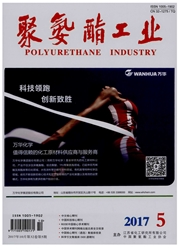

 中文摘要:
中文摘要:
以原竹为材料,经过浸泡、粉碎、干燥等步骤制得竹原纤维,并探讨了竹原纤维作为吸附剂对水体中Pb(Ⅱ)的吸附性能.利用扫描电镜(SEM),红外光谱仪(FT-IR)对竹原纤维的微观形貌以及化学结构进行了观察和分析;并考察了溶液p H值、温度和Pb(Ⅱ)初始浓度对竹原纤维吸附性能的影响;研究了竹原纤维对Pb(Ⅱ)的吸附动力学模型以及数率方程拟合.研究结果表明,竹原纤维表面粗糙、有突起和裂片,有利于竹原纤维对Pb(Ⅱ)的吸附;当溶液p H=5.0,温度为323K,初始浓度为80 mg/L时,竹原纤维对Pb(Ⅱ)吸附效果最佳;竹原纤维对Pb(Ⅱ)的吸附符合二级动力学模型.
 英文摘要:
英文摘要:
Using original bamboo as raw material, bamboo fiber was made after soaking, grinding, drying and other steps. The adsorption property of bamboo fiber for Pb(Ⅱ) in aqueous solution was discussed. SEM, FT -IR had been used to characterize the microstructure and chemical structure of bamboo fiber. The solution pH value, environment temperature, and initial Pb (Ⅱ) concentration on adsorption performance were investigated and the bamboo fibers for Pb (Ⅱ) adsorption kinetics was researched. The results showed that bamboo fiber surface roughness, with projections and lobes, the presence of large amount of active carbonyl and hydroxyl. These structures showed that the bamboo fiber has the potential to adsorb Pb (Ⅱ). When the pH = 5.0, a temperature of 323 K, the initial concentration of 80 mg/L, the adsorption effect was best. The adsorption of bamboo fiber for Pb (Ⅱ) could be in accordance with the two grade kinetics model.
 同期刊论文项目
同期刊论文项目
 同项目期刊论文
同项目期刊论文
 期刊信息
期刊信息
